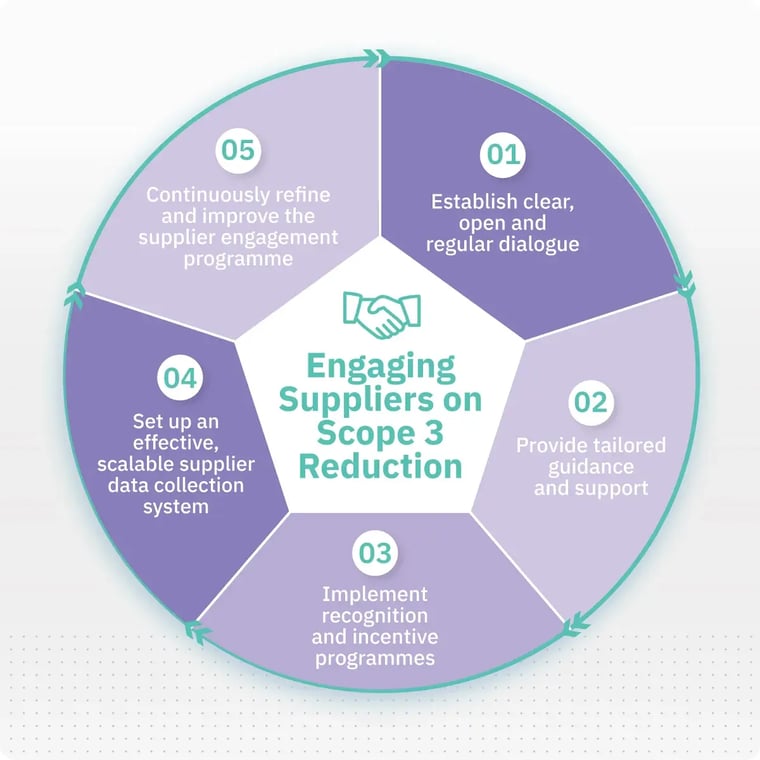Summary
- Effective decarbonisation requires businesses to measure and address Scope 3 emissions, which often exceed operational emissions, representing over 90% of total emissions, highlighting the importance of supplier engagement.
- Companies should cultivate transparent, ongoing communication with suppliers to align emission reduction goals and integrate these into procurement processes, ensuring continuous engagement and data collection for better GHG inventory management.
- Implementing incentive programs can motivate suppliers for enhanced climate performance while establishing a scalable data collection system allows for real-time tracking of progress, facilitating informed decision-making and continuous improvement in supplier engagement strategies.
Businesses committed to decarbonisation and driving real change in their environmental impact must address emissions across all three scopes, with a sharp focus on value chain emissions, known as Scope 3. These emissions often surpass operational emissions by over 10 times, constituting more than 90% of a company's total emissions.
As a result, supplier engagement has emerged as a crucial strategy for meaningful decarbonisation and achieving net zero emissions. However, many companies are new to supplier engagement and have yet to initiate the process with key suppliers. Below are five best practices and strategies your company should consider deploying to effectively engage suppliers on Scope 3 reductions.
Best practices for engaging your suppliers on Scope 3
1. Establish clear, open and regular dialogue:
Establishing a clear, open and regular dialogue with suppliers is essential for successful Scope 3 reduction efforts. Your company’s commitment to transparency and continuous engagement is key to ensuring that your supply chain takes your decarbonisation efforts seriously.
Make sure you clearly communicate your greenhouse gas (GHG) reduction goals and expectations to your suppliers, aligning them with your company's climate targets. Integrate these goals into your existing procurement processes and business interactions to underscore their centrality to your business strategy and foster greater supplier commitment. Avoid setting up separate processes, as this can dilute the focus and importance of your climate initiatives.
Regular and transparent communication also plays a vital role in collecting meaningful emissions from your supply chain. By maintaining frequent communication with your supply chain regarding the process and its outcomes, you can expedite the relevance and quality of your GHG inventory.
Task your procurement team with periodically querying suppliers about their progress on completing surveys and addressing any questions they may have. Regularly discussing climate performance with suppliers enables you to monitor progress, provide feedback, and identify mutual needs and opportunities. Simplify this process by utilising a centralised data collection and information management system that enables tracking of supplier data and progress.
Regular interactions between procurement teams and supplier representatives can take various forms, including training sessions, information exchanges, business reviews, email correspondence, one-to-one meetings, and group discussions. Aim for these engagements to occur at least quarterly, with a recommended minimum frequency of yearly engagements.

2. Provide tailored guidance and support:
Recognise that while some of your suppliers might already have emissions reduction goals and strategies, others may not know where to begin. Direct your suppliers to publicly available tools and resources that can significantly expedite their actions and performance, such as those developed by the GHG Protocol, the Science-Based Targets Initiative (SBTi).
Tailored ad-hoc support is equally important. Provide your suppliers with access to group webinars, third-party services, and personalised one-to-one expert sessions. Ensuring that your suppliers have the specific tools and guidance needed to navigate complex sustainability and climate disclosure requirements effectively is essential for their success – and ultimately, yours.
3. Implement recognition and incentive programmes:
Implementing recognition and incentive programs can serve as a powerful tool to drive supplier action and accelerate progress on Scope 3 reductions. These programs, which are linked to climate performance, complement buyer requirements and help ensure supplier buy-in. Collaborate with internal stakeholders to determine feasible measures and implementation strategies.
While the appropriate approach to incentivising action will vary by company, consider establishing programs to motivate suppliers at different stages of their decarbonisation journey. This could involve rewarding suppliers who demonstrate climate leadership, penalising those lagging behind, or offering preferential conditions linked to climate performance targets.
Options for incentives may include public recognition of supplier climate performance, offering preferential conditions or long-term partnership agreements, providing direct financing for interventions, or leveraging better credit ratings to facilitate supplier loans, among others.
4. Set up an effective and scalable supplier data collection & tracking system:
Establishing an effective and scalable system for collecting and tracking supplier data is crucial for monitoring progress toward Scope 3 reduction goals and driving real change. Consider investing in technology solutions that streamline data collection processes, automate validation and verification, and provide real-time visibility into supplier data quality.
These solutions simplify the tracking of supplier progress, allowing for the identification of trends and areas in need of improvement. They also facilitate alignment and prioritisation by providing information about a single source of truth, accessible to all stakeholders. This ensures that all relevant teams and business units within your company have the necessary information available for effective dialogue and decision-making on supplier engagement.
5. Continuously refine and improve the supplier engagement programme:
Regularly evaluate the effectiveness of your supplier engagement programme, soliciting feedback from both internal stakeholders and suppliers to identify strengths, weaknesses, and areas for improvement. Develop a formal process for reviewing and updating your company’s supplier engagement efforts, setting clear objectives, timelines, and responsibilities. By continuously refining and improving the programme, you can ensure that suppliers remain engaged and committed to achieving your company’s Scope 3 reduction goals.
Why choose Terrascope
In a recent report commissioned by Terrascope, Verdantix discovered that 87% of corporate respondents prioritise supplier engagement capabilities when selecting a software provider in the future.
As decarbonisation software powered by the latest advances in machine learning and AI, Terrascope assists enterprises within the ‘Grown Economy’ on their journey towards net zero. These are companies deeply entrenched in value chains reliant on soft commodities like agricultural products or livestock, as well as land use. Despite spanning various industries such as growers, F&B manufacturing, distribution, retail, hospitality, fashion, and luxury goods, they all face a common challenge: grappling with hard-to-abate Scope 3 emissions that constitute the majority of their emissions footprint.
As you engage your supply chain in Scope 3 reductions, don't let emissions data collection and management hold you back. Terrascope offers:
- Seamless data ingestion, collection and management: Terrascope supports seamless data ingestion with advanced processing methodologies to handle diverse data formats, delivering processing speeds five times faster than manual methods.
- Granular emissions measurement and reduction planning: With AI-powered EF matching and hotspot analytics, Terrascope enhances confidence in emissions data and insights. Our proprietary carbon driver tree allows you to visualise and prioritise emissions hotspots and supplier engagement for impactful decarbonisation efforts.
- Deep supply chain and value chain expertise: Terrascope provides an end-to-end platform with tailored features and services for the intricate value chains characteristic of enterprises in the ‘Grown Economy’.
- Better internal and external collaboration: the Terrascope platform streamlines the measurement, tracking, and reduction of Scope 3 emissions, ensuring everyone is on the same page.
- Comprehensive emissions footprinting: Terrascope combines accurate Corporate Carbon Footprinting (CCF) and Product Carbon Footprinting (PCF) on a single platform. We deliver reliable product-level estimates even without primary supplier data, empowering you to analyse dozens or hundreds of products at once using our PCF Calculator.
Engaging suppliers in reducing Scope 3 emissions is crucial for building a data-driven decarbonisation strategy and driving meaningful reductions in your company’s emissions footprint. By leveraging end-to-end decarbonisation software like Terrascope, businesses can unlock numerous benefits, including improved brand reputation, operational efficiency, regulatory compliance, impactful decarbonisation investments and new revenue streams. Don't let data collection and management challenges hinder your Scope 3 reduction strategies.
Be the first to know.
Join us on LinkedIn to get curated updates monthly.



